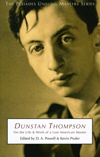Dunstan Thompson
The contemporary American literary scene is as vibrant and diverse as any other art community; thousands of writers and millions of readers participate and interact on a daily basis. But looking back to any past period of the community – say the 1940s and 50s, somewhere in the layover between modernism and postmodernism – the world of letters looks sparse. One can’t help but imagine that literary circles must surely have been as wide and broad as they currently are. But it feels as if so few writers have lasted even such a meager sum of time. We’re often led to believe that there’s a reason past artists fall into obscurity. D. A. Powell and Kevin Prufer prove that notion wrong.
The contemporary American literary scene is as vibrant and diverse as any other art community; thousands of writers and millions of readers participate and interact on a daily basis. But looking back to any past period of the community – say the 1940s and 50s, somewhere in the layover between modernism and postmodernism – the world of letters looks sparse. One can’t help but imagine that literary circles must surely have been as wide and broad as they currently are. But it feels as if so few writers have lasted even such a meager sum of time. We’re often led to believe that there’s a reason past artists fall into obscurity. D. A. Powell and Kevin Prufer prove that notion wrong.
Dunstan Thompson: On the Life & Work of a Lost American Master is a stunning and appropriate first for an ambitious series. Coming from some of the best poetic minds in contemporary America, Dunstan Thompson is the first of the “Unsung American Masters” series, one of which is promised every year from Pleiades Press. The book begins with a short biographical segment, followed by examples of Thompson’s woefully neglected writings. The latter half of Powell and Prufer’s book consists of essays written by well-known writers and critics analyzing Thompson’s work.
And speaking of Thompson’s poetry: it’s good. Damn good. “Unsung Master” good. The included poems are an unusual combination of pious Catholicism, bold sexuality, and war imagery. (Thompson was drafted in WWII). These crafted and subtle lines of homoeroticism lend a great deal of pain and eloquence to Thompson’s style. Here are the first few lines of “This Tall Horseman, My Young Man of Mars:”
This tall horseman, my young man of Mars,
Scatters the gold dust from his hair, and takes
Me to pieces like a gun. The myth forsakes
Him slowly. Almost mortal, he shows the scars
Where medals of honor, cut-steel stars,
Pin death above the heart. But bends, but breaks
In his hand, my love, whose wrecked machinery makes
Time, the inventor, weep through a world of wars.
Thompson’s images are exquisite; his lines, dense. And creating such obvious homosexual poetry was no small feat for the 40s. Several of the critical essays address this point. Jim Elledge makes an especially accurate analysis of Dunstan Thompson’s style, noting “he addressed two readerships – one gay, the other straight – simultaneously, offering the same text to each, a text that made sense to both at the same time.”
During the 1950s, Thompson experienced a religious revival that appears to correspond with the fall of his career and prominence in the literary world, although the arbiter of Thompson’s estate – Philip Trower – argues that the religious poetry Thompson filled his last decades with far exceeds his earlier successes. On this point, the book has no clear opinion, leaving to the reader decisions concerning what makes American masters and how they are lost to the wider world. If Dunstan Thompson is any measure, skill cannot play a role. With a fascinating biography, compelling essays, and poetry that will give you goose bumps, Dunstan Thompson is well worth the discovery.





